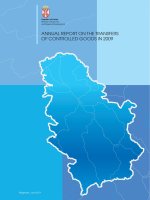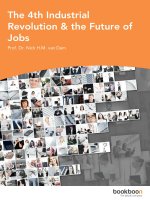World migration report 2010 the future of migration building capacities for change
Bạn đang xem bản rút gọn của tài liệu. Xem và tải ngay bản đầy đủ của tài liệu tại đây (12.43 MB, 295 trang )
WORLD MIGRATION REPORT 2010
The Future of Migration: Building Capacities for Change
WORLD MIGRATION
REPORT 2010
Migration is a constant and dynamic phenomenon increasingly requiring diversified policy intervention in order to
maximize its potential benefits and minimize related costs for both countries of origin and destination as well as
migrants themselves. Better knowledge and enhanced capacities in different policy areas are essential to ensure the
protection of migrants, the facilitation of legal migration, the integration of migrants into the country of destination,
the support for sustainable voluntary return and the greater interlinking between migration and development.
International migration is likely to transform in scale, reach and complexity, due to growing demographic disparities,
the effects of environmental change, new global political and economic dynamics, technological revolutions and
social networks. These transformations will be associated with increasing opportunities, exacerbate existing
problems and generate new challenges.
The World Migration Report 2010 provides a tool for self-evaluation in terms of future scenarios, and demonstrates
the need for a far more comprehensive approach to capacity-building for migration than has typically been
adopted. The aim is not to prescribe ‘one-size-fits-all’ policies and practices, but to suggest objectives of migration
management policies in each area, to stimulate thinking and provide examples of what States and other actors can
do.
Part A of the report focuses on identifying core capacities in key areas of migration management, raising key
concepts and outlining important examples of existing practices in these areas. Part B provides an overview of
migration in the world today, from both the global perspective and through six regional chapters, drawn from the
most up-to-date data.
ISBN 978-92-9068-590-6
ISSN 1561-5502
USD 60.00
THE FUTURE OF MIGRATION:
WORLD MIGRATION REPORT 2010
The challenge remains in translating improved understandings into policy and practice on the ground. State
capacities around the world for managing migration are limited. Legal frameworks may need to be updated or
overhauled to focus on new areas of migration, or to handle new influxes or outflows of migrants; staff working
on the front line may need equipment, training and support; civil society and migrants themselves may not be
adequately integrated into the process of data-gathering and making and implementing policy; vulnerability factors
and health risks inherent to the migration process need to be better understood and addressed.
BUILDING CAPACITIES
FOR CHANGE
WORLD MIGRATION REPORT 2010
THE FUTURE OF MIGRATION:
BUILDING CAPACITIES
FOR CHANGE
This volume is the fruit of a collaborative effort by a team of contributing authors and the Editorial Team under
the direction of the Editors-in-Chief. The findings, interpretations and conclusions expressed herein do not
necessarily reflect the views of IOM or its Member States. The designations employed and the presentation
of material throughout the work do not imply the expression of any opinion whatsoever on the part of IOM
concerning the legal status of any country, territory, city or area, or of its authorities, or concerning its frontiers
or boundaries.
Unless otherwise stated, this volume does not refer to events occurring after August 2010.
IOM is committed to the principle that humane and orderly migration benefits migrants and society. As an
intergovernmental organization, IOM acts with its partners in the international community to: assist in meeting
the operational challenges of migration; advance understanding of migration issues; encourage social and
economic development through migration; and uphold the human dignity and well-being of migrants.
Publisher:
International Organization for Migration
17 route des Morillons
1211 Geneva 19
Switzerland
Tel.: +41 22 717 91 11
Fax: +41 22 798 61 50
E-mail:
Internet:
© 2010 International Organization for Migration (IOM)
ISSN 1561-5502
ISBN 978-92-9068-590-6
All rights reserved. No part of this publication may be reproduced, stored in a retrieval system, or transmitted
in any form or by any means, electronic, mechanical, photocopying, recording, or otherwise without the prior
written permission of the publisher.
Printed in France by Imprimerie Courand et Associés.
07_10
IOM Editorial Team
Khalid Koser, Frank Laczko
Managing Editor
Michele Klein Solomon
Writing Team
Part A: Khalid Koser
Part B: Frank Laczko, Christine Aghazarm, Rudolf Anich,
Pierpaolo Capalbo, Ramiro Flores Cruz, Jobst Koehler,
Susanne Melde, Roberto Pitea, Julia Schad, Paul Tacon
External Advisory Board
Aderanti Adepoju, Stefano Bertozzi, Rolando García,
Graeme Hugo, Binod Khadria, Agustín Escobar Latapí,
Hye-Kyung Lee, Susan Martin, Rainer Münz, Kathleen
Newland, Nasra Shah, Ronald Skeldon
Editorial Assistance
William Barriga, Peter Bosch, Graeme Hugo, David
Knight, Erika Laubacher-Kubat, Rainer Münz, Paola
Pace, Nasra Shah, Peter Schatzer, Ronald Skeldon,
Elizabeth Warn, Jian Zhao
Publications Coordinator
Valerie Hagger
Publications Assistance and Layout
Clara Francia Anaya, Anna Lyn Constantino
Translators
Carmen Andreu, Fabienne Witt, and the TRS team
Executive Assistance
Frances Solinap, Antoinette Wills
Cartography
Oxford Cartographers, Rudolf Anich, Valerie Hagger
Language Editors
Susan Parker, Olga Sheean
WORLD MIGRATION REPORT 2010 | IOM EDITORIAL TEAM
Editors-In-Chief and Concept
iii
ACKNOWLEDGEMENTS
The Editorial Team wishes to thank all
contributing authors and is especially grateful
to Mr. William Lacy Swing, IOM Director
General, for his vision and encouragement to
produce this publication.
The Editorial Team wishes to thank the following external experts for their contribution to
the concept of the World Migration Report
2010 at a workshop in December 2009:
The Editorial Team would also like to thank all
authors of the background papers covered by
the WMR 2010: Aderanti Adepoju, Dovelyn
Agunias, Alexander Betts, Ryzsard Cholewinski,
Mohamed Dito, Bimal Ghosh, Randall Hansen,
Thomas Huddleston, Graeme Hugo, Greg
Irving, Binod Khadria, Jobst Koehler, Agustín
Escobar Latapí, Hye-kyung Lee, Philip Martin,
Susan Martin, Rainer Münz, Elizabeth ThomasHope, Rachel Sabates-Wheeler, Nasra Shah.
All background papers are listed and can be
downloaded at: />Jahia/policy-research/migration-research/
world-migration-report-2010/backgroundpapers
The contribution of the following speakers at
the WMR 2010 Inter-agency Seminar Series
focusing on ‘capacity-building for change’
is equally appreciated: Dovelyn Agunias,
Richard Brown, Laura Chappell, Bimal Ghosh,
Jim Hollifield, Robert Holzmann, Greg Irving,
Khalid Koser, Lindsay Lowell, Sergio Marchi,
Luigi Melica, Rainer Münz, Nadan Petrovic,
Nuria Díaz Sacristán, Isabel Shutes, Carlos
Varga-Silva.
WORLD MIGRATION REPORT 2010 | ACKNOWLEDGEMENTS
Elizabeth Adjei (Ghana Immigration Service),
Stefano Bertozzi (European Commission,
Bureau of European Policy Advisers, Belgium),
John Bingham (International Catholic
Migration Commission – ICMC, Switzerland),
Alexander Chuplygin (Migration and Refugees
Division, Ministry of Foreign Affairs, Russian
Federation), Elizabeth Collett (European
Policy Centre – EPC, Belgium), Yvette de la
Cruz (Public Services International – PSI,
France), Mohammed Dito (Labour Market
Regulatory Agency – LMRA, Bahrain), Rolando
Garcia (Instituto Nacional de Migración,
Coordinación de Relaciones Internacionales e
Interinstitucionales, México), Manuel Imson
(Permanent Mission of the Philippines to the
United Nations Office in Geneva, Switzerland),
Anil Kumar Kokil (Ministry of Finance and
Economic Empowerment, Mauritius), Khalid
Koser (Geneva Centre for Security Policy
– GCSP, Switzerland), Pascal Rey (Office
fédéral des migrations – ODM, Switzerland),
Wies Maas (The Hague Process on Refugees
and Migration, Netherlands), Ellene Sana
(Asian Migrant Forum, Philippines), Ronald
Skeldon (Department for International
Development, United Kingdom), Diana Veloz
(Embassy of Ecuador in Egypt), Simona Vezzoli
(International Migration Institute – IMI,
United Kingdom), Vincent Williams (Institute
for a Democratic Alternative in South Africa –
IDASA, South Africa).
v
A complete list of the seminars and related information can be found online at: http://www.
iom.int/jahia/Jahia/policy-research/migration-research/world-migration-report-2010/
interagency-seminar-series
The Editorial Team is grateful also to Solon
Ardittis from Eurasylum Ltd. for conducting
monthly policy interviews on the ‘The Future
of Migration: Building Capacities for Change’’.
Interviews can be accessed at: http://www.
eurasylum.org /Portal/DesktopDefault.
aspx?tabindex=4&tabid=19
WORLD MIGRATION REPORT 2010 | ACKNOWLEDGEMENTS
Several organizations generously shared
their data and other research materials
which allowed, inter alia, the preparation of
informative textboxes:
vi
Citizenship and Immigration Canada (CIC),
Eurasylum, High Commission for Immigration
and Intercultural Dialogue (ACIDI), Instituto
Nacional de Migración (INM), International
Catholic Migration Commission (ICMC),
International Labour Organization (ILO), Public
Services International (PSI), United Nations
Children’s Fund (UNICEF), United Nations
Development Programme (UNDP), United
Nations Environment Programme (UNEP),
United Nations Institute for Training and
Research (UNITAR), University of Adelaide,
Australia.
The Editorial Team is especially grateful to the
following donors for their generous financial
support towards the development and publication of the World Migration Report 2010:
Governments of Australia, Italy, Sweden and
Switzerland, and The John D. and Catherine T.
MacArthur Foundation.
List of WMR 2010
Background Papers
/>Future Trends in Migration: Regional Perspectives
• “The Future of Migration Policies in Africa” by Aderanti Adepoju
• “The Future of Migration Policies in the Asia-Pacific Region” by Graeme Hugo
• “The Future of Migration Policies in the Americas” by Agustín Escobar Latapí
• “The Future of European Migration: Policy Options for the European Union and its Member
States” by Rainer Münz and Elizabeth Collett
• “Building Capacity to Manage Labour Mobility in Gulf Cooperation Council (GCC) Countries”
by Mohamed Dito
• “Building State Capacities for Managing Contract Worker Mobility: The Asia – GCC Context”
by Nasra Shah
• “The Future of Migration Policies in the Caribbean” by Elizabeth Thomas-Hope
Migration and its Linkages with Employment, Health, Integration and Development
• “The Future of Diaspora Policy” by Dovelyn Agunias
• “The Future of Integration Policy” by Thomas Huddleston
• “Family Migration Issues in North-East Asia” by Hye-Kyung Lee
• “Future Capacity Needs in Managing the Health Aspects of Migration” by Greg Irving and
Davide Mosca
• “The Future of Health Worker Migration” by Binod Khadria
• “Welfare Provision for Migrants: Current Trends and Future Challenges” by Rachel SabatesWheeler
Climate Change and Environmental Degradation: Migration as an Adaptation Strategy
• “Climate Change and International Migration” by Susan Martin
WORLD MIGRATION REPORT 2010 | LIST OF WMR 2010 BACKGROUND PAPERS
Migration Governance and Irregular Migration
• “Migration Governance: Alternative Futures” by Alexander Betts
• “Irregular Migration and Mixed Flows” by Ryszard Cholewinski
• “The Global Economic Crisis and Governance of Human Mobility: Can We Turn the Current
Crisis Into a New Global Opportunity for the Future?” by Bimal Gosh
• “The Future of Migration Governance and Regional Consultative Processes” by Jobst
Koehler and Randall Hansen
• “The Future of Labour Migration Costs” by Philip Martin
vii
List of WMR 2010
Inter-agency Seminars
/>• “Approaches and Capacity Needs in Managing the Health Aspects of Migration” by Greg
Irving, Health Programme Officer of the International Organization for Migration (IOM),
Regional Mission for East & Central Africa.
• “Portability of Pension, Health, and other Social Benefits: Facts, Concepts, Issues” by Robert
Holzmann, Research Director of the Labor Market Program at the Marseille Center for
Mediterranean Integration (CMI).
• “The Future of Diaspora Policy: Building Government Capacity for Diaspora Engagement” by
Dovelyn Agunias, Policy Analyst, Migration Policy Institute (MPI).
WORLD MIGRATION REPORT 2010 | LIST OF WMR 2010 INTER-AGENCY SEMINARS
• “The Impacts of Remittances on Poverty: Some Lessons from Asia and South Pacific” by
Richard Brown, Associate Professor at the School of Economics, University of Queensland.
viii
• “The Global Economic Crisis and Migration: Where Do We Go from Here?” by Bimal Ghosh,
Emeritus Professor at the Columbia Graduate School of Public Administration.
• “Development on the Move: The Place of Migration in Future Development Strategies” by
Laura Chappell, Senior Research Fellow, Institute for Public Policy Research (IPPR).
• “The Role of Local and Regional Authorities in Migration Management” by Nadan Petrovic,
along with Prof. Luigi Melica and Nuria Díaz Sacristán.
• “Global Migration Futures Project” by Carlos Varga-Silva, International Migration Institute
(IMI).
• “The Role of Migrant Care Workers in Ageing Societies” by Lindsay Lowell, Director of Policy
Studies, Institute for the Study of International Migration, Georgetown University.
• “Connecting the Dots: A Fresh Look at Managing International Migration” by Sergio Marchi,
Special Advisor to the Secretary General, International Catholic Migration Commission
(ICMC).
• “The Future of Migration Policy: Long term Responses” by Rainer Münz, Head of Research
and Development, Erste Group Bank.
• “A Public Goods Approach to Managing Migration” by James F. Hollifield, Director of the
Tower Center for Political Studies, SMU.
• “The Future of Migration: Building Capacities for Change” by Khalid Koser, Associate Dean
and Head, New Issues in Security Programme.
WMR 2010 Eurasylum’s
monthly policy
interviews
/>Prof. Bimal Ghosh, Emeritus Professor at the Columbia Graduate School of Public Administration;
former Senior UN Director; and Ambassador Sergio Marchi, Senior Fellow at the International
Centre for Trade and Sustainable Development (ICTSD); former Minister of Citizenship and
Immigration of Canada on “Migration governance: towards a global integrated migration
regime?” - 06/2010.
Prof. Wiseman Nkuhlu, President of the International Organisation of Employers (IOE); and
Nand Kishore Singh, Member of the Indian Parliament; former Secretary to the Prime Minister
of India and former Joint Secretary of the Ministry of Home Affairs on “The future of international
labour migration” - 04/2010.
Dr. Howard Duncan, Executive Director of Metropolis, Citizenship and Immigration Canada;
and Prof. Michael Keith, Director of the Centre on Migration, Policy, and Society (COMPAS),
University of Oxford; former member of the UK Government’s Commission on Integration and
Cohesion on “Integration and rights of migrants: policy priorities and directions for new capacity
building measures” - 03/2010.
Theodoros Skylakakis, Member of the European Parliament; former Special Representative for
Climate Change of Greece on “Climate change and migration: impacts and policy responses” 02/2010.
WORLD MIGRATION REPORT 2010 | WMR 2010 EURASYLUM’S MONTHLY POLICY INTERVIEWS
Patricia Sto Tomas, Chair of the National Development Bank of the Philippines; former Secretary
of Labor and Employment of the Philippines; former GCIM Commissioner; and Dilip Ratha, Lead
Economist, Development Prospects Group, and Manager, Migration and Remittances, the World
Bank, Washington, D.C. on “Migration and development: recent and unfolding experiences” 05/2010.
ix
Table of Contents
IOM Editorial Team........................................................................................................iii
ACKNOWLEDGEMENTS.......................................................................................................v
List of WMR 2010 Background Papers.......................................................................vii
List of WMR 2010 Interagency Seminars................................................................. viii
WMR 2010 Eurasylum’s monthly policy interviews..............................................ix
LIst of Figures and MAPS............................................................................................ xiv
FOREWORD....................................................................................................................... xix
Building capacities for change. ......................................................................1
1.The global outlook for migration........................................................................................... 3
2.Capacity-building................................................................................................................... 7
3.Labour mobility................................................................................................................... 11
3.1 Determining policy goals................................................................................................ 12
3.2 Assessing labour and skills shortages............................................................................. 14
3.3 Regulating admissions and selecting migrant workers.................................................. 15
3.4 Determining conditions attached to employment permits............................................ 18
3.5 Training of migrant workers and placement services..................................................... 20
3.6 Protection of migrant workers’ rights............................................................................ 21
3.7 Reducing labour migration costs.................................................................................... 23
3.8 Strengthening and implementing bilateral labour mobility agreements....................... 24
3.9 Return and reintegration................................................................................................ 25
3.10 Implementation............................................................................................................. 26
4.1 Better data on irregular migration................................................................................. 31
4.2 Law-enforcement strategies........................................................................................... 33
4.3 Regularization................................................................................................................ 35
4.4 Detention and return..................................................................................................... 36
4.5 Regulating migration and employment.......................................................................... 37
4.6 Capacity-building in transit States.................................................................................. 38
4.7 Combating migrant smuggling and human trafficking................................................... 39
4.8 Mixed flows.................................................................................................................... 40
4.9 Information campaigns ................................................................................................. 42
4.10 Partnerships and cooperation........................................................................................ 43
5.Migration and development............................................................................................... 45
5.1 Mainstreaming migration in development plans........................................................... 46
5.2 Optimizing formal remittance flows............................................................................... 47
5.3 Enhancing the developmental impacts of remittances.................................................. 49
5.4 Engaging diasporas........................................................................................................ 50
5.5 Consolidating knowledge networks............................................................................... 52
5.6 Strengthening the links between return and development........................................... 52
5.7 Promoting circular migration......................................................................................... 53
5.8 Training to retain............................................................................................................ 55
5.9 Ethical recruitment policies........................................................................................... 55
5.10 Institutional capacity-building........................................................................................ 56
WORLD MIGRATION REPORT 2010 | TABLE OF CONTENTS
4.Irregular migration.............................................................................................................. 29
xi
6.Integration........................................................................................................................... 57
6.1 Strengthening economic participation........................................................................... 58
6.2 Encouraging civic participation among migrants........................................................... 60
6.3 Simplifying rules on citizenship, nationality and dual nationality.................................. 61
6.4 Family migration............................................................................................................ 62
6.5 Managing temporary migration..................................................................................... 65
6.6 Promoting migrant education........................................................................................ 65
6.7 Strengthening anti-discrimination policies and practices.............................................. 67
6.8 Promoting migrant health.............................................................................................. 67
6.9 Fostering public dialogue............................................................................................... 70
6.10 Mainstreaming integration across government............................................................. 70
7.Environmental change........................................................................................................ 73
7.1 Establishing a better evidence base............................................................................... 74
7.2 Disaster risk reduction................................................................................................... 75
7.3 Developing adaptation strategies.................................................................................. 77
7.4 Preparing evacuation plans............................................................................................ 79
7.5 Filling gaps in the legal and normative framework........................................................ 79
7.6 Implementing national laws and policies on internal displacement.............................. 81
7.7 Amending national immigration laws and policies........................................................ 82
7.8 Establishing proactive resettlement policies.................................................................. 83
7.9 Providing humanitarian assistance................................................................................ 84
7.10 Planning for return and resettlement............................................................................ 84
8.Migration governance......................................................................................................... 87
8.1 Developing a national migration policy.......................................................................... 88
8.2 Strengthening migration management at the national level......................................... 89
8.3 Coordinated policymaking and implementation............................................................ 89
8.4 The need for better research and data.......................................................................... 91
8.5 Policy evaluation............................................................................................................ 94
8.6 Developing urban governance....................................................................................... 95
8.7 Engagement with the private sector.............................................................................. 96
8.8 An enhanced role for civil society.................................................................................. 97
8.9 Effective RCPs and cooperation between regional processes........................................ 98
8.10 Addressing the need for more coherent global governance.......................................... 99
WORLD MIGRATION REPORT 2010 | TABLE OF CONTENTS
9.Next steps.......................................................................................................................... 101
xii
Checklist of core capacities in international migration........................................................ 104
References............................................................................................................................. 105
An overview of international migration trends.......................111
Introduction.......................................................................................................................... 113
Regions................................................................................................................................. 113
Global overview of migration................................................................................................115
Global stocks........................................................................................................................ 115
Remittances.......................................................................................................................... 117
Internally displaced persons................................................................................................. 119
Refugees............................................................................................................................... 119
Health migration.................................................................................................................. 119
Student mobility................................................................................................................... 120
Irregular migration............................................................................................................... 120
Environment......................................................................................................................... 121
Migration and the economic crisis 2008–2010.................................................................... 122
References............................................................................................................................ 125
Africa regional overview ...................................................................................................... 127
East and Central Africa......................................................................................................... 129
North Africa.......................................................................................................................... 134
Southern Africa.................................................................................................................... 138
West Africa........................................................................................................................... 140
Effects of the economic crisis............................................................................................... 144
References............................................................................................................................ 147
Americas regional overview.................................................................................................. 149
North America...................................................................................................................... 150
United States of America...................................................................................................... 152
Canada.................................................................................................................................. 153
Latin America and the Caribbean......................................................................................... 153
Effects of the economic crisis............................................................................................... 158
Unemployment............................................................................................................. 158
Remittances . ................................................................................................................ 159
Irregular migration........................................................................................................ 160
Return........................................................................................................................... 161
Policy responses............................................................................................................ 161
References............................................................................................................................ 163
Asia regional overview.......................................................................................................... 165
East Asia............................................................................................................................... 169
South-East Asia..................................................................................................................... 170
South-Central Asia................................................................................................................ 172
Effects of the economic crisis............................................................................................... 175
Unemployment and return........................................................................................... 175
Remittances................................................................................................................... 176
Policy responses in destination and source countries................................................... 177
References............................................................................................................................ 179
Europe regional overview..................................................................................................... 183
Western and Central Europe................................................................................................ 185
Eastern Europe and Central Asia.......................................................................................... 190
Effects of the economic crisis .............................................................................................. 195
Remittances................................................................................................................... 199
References............................................................................................................................ 202
Arab Mashreq....................................................................................................................... 206
GCC countries....................................................................................................................... 209
Israel..................................................................................................................................... 211
Effects of the economic crisis............................................................................................... 213
References............................................................................................................................ 217
Oceania regional overview.................................................................................................... 219
Australia and New Zealand . ................................................................................................ 221
Melanesia, Polynesia and Micronesia ................................................................................. 227
Effects of the economic crisis............................................................................................... 229
References............................................................................................................................ 234
Annex: Migration data: comparability, quality and limitations.............................................237
Immigration and emigration................................................................................................. 238
Immigration estimates.................................................................................................. 238
Emigration estimates..................................................................................................... 238
Remittances.......................................................................................................................... 240
World Bank data on remittances................................................................................... 240
References............................................................................................................................ 242
MAPS................................................................................................................................. 243
WORLD MIGRATION REPORT 2010 | TABLE OF CONTENTS
Middle East regional overview..............................................................................................205
xiii
LIst of Figures and MAPS
GLOBAL OVERVIEW OF MIGRATION
Figure 1: Countries with the largest foreign-born
populations in 2010 (in millions).............. 115
Figure 2: Percentage of foreign-born in
population in 2010.................................... 116
Figure 3: Countries with the largest emigrant
populations in 2000 (in millions).............. 117
Figure 4: Top ten remittance receivers in
2009 (in USD millions).............................. 118
Figure 5: Percentage of GDP in 2008 represented
by remittances ......................................... 118
AFRICA REGIONAL OVERVIEW
Figure 1: African emigrants, by region of origin
and destination, in 2000 (in millions)....... 128
Figure 2: Percentage growth of remittance
inflows in sub-Saharan Africa
2007–2010................................................ 129
WORLD MIGRATION REPORT 2010 | LIST OF FIGURES AND MAPS
Figure 3: Stock of migrants in East and
Central Africa, by destination: top ten
destinations in 2000, 2005 and
2010 (in thousands).................................. 130
xiv
Figure 4: Stock of migrants, as a percentage
of total population, in East and Central
Africa, by destination: top ten
destinations in 2000, 2005 and 2010........ 131
Figure 5: Internally displaced persons (IDPs)
in East and Central Africa.......................... 132
Figure 6: Remittance inflows to East and
Central Africa in 2007–2009
(in USD millions)....................................... 133
Figure 13: Remittance outflows from North Africa
in 2006–2008 (in USD millions)................. 137
Figure 14: Stock of migrants in Southern Africa,
by destination, in 2000, 2005 and
2010 (in thousands).................................. 138
Figure 15: Stock of migrants as a percentage of
total population in Southern Africa
in 2000, 2005 and 2010............................ 139
Figure 16: Remittance inflows in Southern Africa
in 2007–2009 (in USD millions)................. 139
Figure 17: Remittance inflows in Southern Africa,
as a percentage of GDP, in 2008............... 140
Figure 18: Stock of migrants in West Africa,
by destination: top ten destinations
in 2000, 2005 and 2010
(in thousands) .......................................... 141
Figure 19: Stock of migrants as a percentage of
total population in West Africa: top ten
destinations in 2000, 2005 and 2010........ 142
Figure 20: Remittance inflows in West Africa,
as a percentage of GDP: top five
countries in 2008 ..................................... 143
Figure 21: Year-on-year growth in remittance
inflows, per quarter, for selected
countries in North and West Africa
in 2008–2009 (in %).................................. 145
Figure 22: Year-on-year growth in remittance
inflows, per quarter, for selected
countries in East Africa in 2008–2009
(in %)......................................................... 145
AMERICAS REGIONAL OVERVIEW
Figure 7: Remittance inflows in East and
Central Africa as a share of GDP:
top five countries in 2008 (in %)............... 133
Figure 1: Net migration rates per 1,000
population in 2000–2005 and
2005–2010................................................ 149
Figure 8: Remittance outflows from East and
Central Africa: top five countries in
2006–2008 (in USD millions).................... 134
Figure 2a: Stock of migrants in the USA and
Canada, in 2000, 2005 and 2010 (in
thousands)................................................ 150
Figure 9: Stock of migrants in North Africa,
by destination, in 2000, 2005 and
2010 (in thousands).................................. 135
Figure 2b: Stock of migrants in North America,
as a share of total population,
in 2000, 2005 and 2010 (in %).................. 151
Figure 10: Stock of migrants in North Africa, by
destination, as a percentage of total
population, in 2000, 2005 and 2010......... 135
Figure 3a: Emigration in North America in
2000 (in thousands) ................................. 151
Figure 11: Remittance inflows in North Africa
in 2007–2009 (in USD millions)................. 136
Figure 12: Remittance inflows in North Africa,
as a percentage of GDP, in 2008............... 136
Figure 3b: Emigration in North America, as a
share of total population,
in 2000 (in %) ........................................... 152
Figure 4: Foreign-born population by region of
birth for the USA: 1960–2008
(in millions)............................................... 152
Figure 5a: Stock of migrants in Latin America
and the Caribbean: top ten destinations
in 2000, 2005 and 2010
(in thousands)........................................... 154
Figure 5b: Stock of migrants in Latin America
and the Caribbean, as a share of total
population, in 2000, 2005 and 2010
(in %)......................................................... 154
Figure 6a: Emigrants in Latin America and the
Caribbean, top ten countries in 2000
(in thousands)........................................... 155
Figure 6b: Emigrants in Latin America and the
Caribbean, as share of total population,
top ten countries in 2000 (in %)............... 156
Figure 7: Destination countries of emigrants from
Latin America and the Caribbean
(LAC) in 2000 (in %)................................... 156
Figure 8:
Remittance inflows to the top ten
recipient countries in Latin America
and the Caribbean, 2000–2008
(in USD millions)....................................... 158
Figure 9: Latin American and Caribbean remittance
recipients with the largest recent
declines in remittances in 2004–2009
(in %) ........................................................ 160
ASIA REGIONAL OVERVIEW
Figure 1: Female migrants as a percentage of
international migrants in 2000, 2005
and 2010 .................................................. 165
Figure 3: Top ten emigration countries in Asia
in 2000 (in millions).................................. 166
Figure 4a: Stock of emigrants from Asia, by region
of destination, in 2000 (in %).................... 167
Figure 4b: Stock of emigrants from Asia, by country
of destination, in 2000 (in millions).......... 167
Figure 5a: Remittance inflows to selected
countries in Asia in 2002–2008
(in USD millions) ...................................... 168
Figure 5b: Remittance outflows from selected
countries in Asia in 2002–2008 (in USD
millions) ................................................... 168
Figure 6a: Stock of migrants in East Asia, by
destination, in 2000, 2005 and 2010
(in thousands) .......................................... 169
Figure 6b: Stock of migrants in East Asia, as share
of total population, in 2000, 2005 and
2010 (in %)................................................ 169
Figure 7: Remittance inflows to East Asia in
2000–2009 (in USD millions).................... 170
Figure 8b: Stock of migrants in South-East Asia,
as share of total population, in 2000,
2005 and 2010 (in %)................................ 171
Figure 9: Remittance inflows to selected
South-East Asia countries in 2000–2009
(in USD millions)....................................... 172
Figure 10a: Stock of migrants in South-Central Asia,
by destination, in 2000, 2005 and
2010 (in thousands)................................. 173
Figure 10b: Stock of migrants in South-Central Asia,
as share of total population, in 2000,
2005 and 2010 (in %)............................... 173
Figure 11: Remittance inflows to selected countries
in South-Central Asia in 2000–2009
(in USD millions)....................................... 174
Figure 12: Overseas employment of workers from
Bangladesh in 2009 (in thousands)........... 175
Figure 13: Deployment of land-based overseas
Filipino workers, by region of destination
(new hires and rehires, excluding
seafarers), in 2002–2008
(in thousands)........................................... 176
EUROPE REGIONAL OVERVIEW
Figure 1:
Net migration rates per 1,000
population in selected European
countries in 1990–1995 and
2005–2010 ............................................... 183
Figure 2: Total number of European emigrants
in 2000, by region of origin and
destination (in millions) ........................... 184
Figure 3:
Stock of migrants in Western and
Central Europe, by destination:
top ten destinations in 2000, 2005
and 2010 (in thousands)........................... 186
Figure 4: Stock of migrants, by destination, as a
percentage of total population in Western
and Central Europe: top ten destinations
in 2000, 2005 and 2010............................ 187
Figure 5: Inflows and outflows of foreign-born
population in selected EU countries
in 2007 (in thousands).............................. 188
Figure 6: Stock of migrants from the EU-15 in
selected European countries in 2007
(in thousands)........................................... 189
Figure 7: Remittance outflows from Western and
Central Europe in 2006, 2007 and 2008
(in USD million)......................................... 189
Figure 8: Remittance inflows to Western and
Central Europe, as a percentage of
GDP in 2008: top five countries................ 190
WORLD MIGRATION REPORT 2010 | LIST OF FIGURES AND MAPS
Figure 2: Net migration rate per 1,000 population
in 1995–2000, 2000–2005 and
2005–2010 ............................................... 166
Figure 8a: Stock of migrants in South-East Asia,
by destination, in 2000, 2005 and
2010 (in thousands) ................................. 171
xv
Figure 9: Stock of migrants in Eastern Europe
and Central Asia, by destination: top ten
destinations in 2000, 2005 and 2010
(in thousands)........................................... 191
Figure 7:
Figure 10: Stock of migrants in Eastern Europe and
Central Asia, by destination, as a
percentage of total population: top ten
destinations in 2000, 2005 and 2010........ 192
Figure 8: Remittance outflows from Gulf Cooperation
Council countries in 2006–2008
(in USD millions)....................................... 211
Figure 11: Remittance inflows in Eastern Europe
and Central Asia: top five countries
in 2007–2009 (in USD millions)................. 193
Figure 12: Remittance inflows in Eastern Europe
and Central Asia in 2008, as a
percentage of GDP: top five countries...... 194
Figure 13: Remittance outflows from Eastern Europe
and Central Asia in 2006–2008:
top three countries (in USD millions)........ 194
Figure 14: Unemployment rates in EU-27
countries in 2008–2009 (in %).................. 195
Figure 15: Changes in unemployment rates for
selected EU countries in 2007–2009
(in %)......................................................... 196
Figure 16: National insurance registrations to
overseas adult nationals entering the
United Kingdom in 2008–2009
(in thousands)..........................................197
WORLD MIGRATION REPORT 2010 | LIST OF FIGURES AND MAPS
Figure 17: Numbers of forced removals from
selected EU countries in 2007–2009........ 199
xvi
Figure 18: Growth in remittance inflows between
2008 and 2009, in USD terms (in %)......... 200
Figure 19: Remittance outflows from EU to
non-EU countries in 2008–2009 (in %)..... 201
MIDDLE EAST REGIONAL OVERVIEW
Figure 1: Net international migration rate per
1,000 population in 2000–2005 and
2005–2010................................................ 205
Figure 2: Stock of migrants in the Arab Mashreq
in 2000, 2005 and 2010
(in thousands) .......................................... 206
Figure 3: Stock of migrants in the Arab Mashreq,
as a percentage of the total population,
in 2000, 2005 and 2010............................ 207
Figure 4: Total number of emigrants from Arab
Mashreq countries in 2000, by country
of origin and region of destination
(in thousands)........................................... 207
Figure 5: Remittance inflows in Arab Mashreq,
as a percentage of GDP, in 2008............... 208
Figure 6: Stock of migrants in Gulf Cooperation
Council countries in 2000, 2005 and
2010 (in thousands).................................. 209
Stock of migrants in Gulf Cooperation
Council countries, as a percentage
of the total population, in 2000,
2005 and 2010.......................................... 210
Figure 9: Stock of migrants in Israel in 2000,
2005 and 2010 (in thousands).................. 211
Figure 10: Stock of migrants in Israel, as a
percentage of total population, in
2000, 2005 and 2010................................ 212
Figure 11: Growth in remittance flows in Israel
in 2008 and 2009 (in %)............................ 212
Figure 12: Migrant flows from Bangladesh, Pakistan
and the Philippines to GCC countries
(in thousands), and oil prices
(in USD per barrel), 1999–2009................ 213
Figure 13: Growth of remittance inflows in
selected Mashreq countries,
2008–2009 (in %)...................................... 214
Figure 14: Growth of remittance inflows to Egypt,
according to sending country,
2008–2009 (in %)...................................... 215
Figure 15: Growth of remittance outflows from
GCC countries to Egypt in 2009 (in %)...... 216
Figure 16: Remittance outflows from GCC
countries to Pakistan in 2009 (in %).......... 216
OCEANIA REGIONAL OVERVIEW
Figure 1: Stock of migrants (in thousands) and
share of total population (in %) in
Oceania in 2000, 2005 and 2010.............. 219
Figure 2: Emigrants from Oceania, by place
of origin, in 2000 (in %)............................. 220
Figure 3a: Stock of migrants in Australia and New
Zealand in 2000, 2005 and 2010
(in thousands)........................................... 221
Figure 3b: Stock of migrants as a percentage of
total population in Australia and
New Zealand in 2000, 2005 and 2010...... 221
Figure 4a: Emigrants from Australia in 2000,
by country of destination (in %)................ 222
Figure 4b: Emigrants from New Zealand in 2000,
by country of destination (in %)................ 222
Figure 5: Net migration rates per 1,000 population
from Australia and New Zealand in
1995–2000, 2000–2005 and
2005–2010................................................ 223
Figure 6: Net migration from New Zealand, by
country of residence: top four
countries in 2001–2009 (in thousands).... 224
Figure 7: Foreign workers in Australia: total stock
(in thousands) and as a share of the
labour force (in %) in 2000–2007.............. 224
Figure 8:
Comparison between inflows of
permanent settlers and inflows of
temporary foreign workers to Australia
in 2000–2007 (in thousands).................... 225
Figure 9:
Comparison between inflows of
permanent settlers and inflows of
temporary foreign workers to
New Zealand in 2000–2007
(in thousands)........................................... 225
MAPS
Map 1:
Immigrant growth rates (2005–2010),
immigrant stocks and immigrants
as a percentage of total population
in 2010...................................................... 244
Map 2:
Female migrants as a percentage of
international migrant stock, 2010............. 246
Map 3:
Total population change in Europe
due to net migration and natural
population change (NPC), 2008................ 248
Map 4:
IOM Assisted Victims of Human
Trafficking (VoT), by country of
origin, 2000–2009..................................... 250
Map 5:
IOM Assisted Victims of Human
Trafficking (VoT), by country of
destination, 2000–2009............................ 251
Map 6:
Signatures/ratifications of the UN
Palermo Protocol on human trafficking,
January 2010............................................. 253
Map 7:
Remittances and foreign aid, total
values and ratio by region, 2007............... 255
Figure 12: Pacific Islands’ emigrants, by country/
region of destination, in 2000 (in %)......... 228
Map 8:
Growth in the number of natural
disasters.................................................... 257
Figure 13: Net migration rates per 1,000
population in Polynesia, Micronesia and
Melanesia in 1995–2000, 2000–2005
and 2005–2010......................................... 229
Map 9:
Memberships of regional consultative
processes (RCPs), January 2010................ 259
Figure 10: Student arrivals in Australia, by country
of birth: top five countries in
2006–2008 ............................................... 226
Figure 11a: Stock of migrants in Melanesia,
Polynesia and Micronesia in 2000,
2005 and 2010 (in thousands)................. 227
Figure 11b: Stock of migrants as a percentage
of total population in Melanesia,
Polynesia and Micronesia in 2000,
2005 and 2010......................................... 227
Figure 15: Remittance outflows from Australia
and New Zealand in 2000–2008
(in USD millions)....................................... 230
Figure 16: Remittance inflows to Pacific Islands
in 2004–2009: selected countries
(in USD millions)....................................... 232
Figure 17: Remittance inflows to selected Pacific
Islands in 2008, as a share of
GDP (in %)................................................. 233
Figure 18: GDP annual percentage change in
selected Pacific Island countries,
2005–2010................................................ 233
Map 11: Internally displaced persons worldwide:
March 2010............................................... 263
Map 12: World’s refugees by region of asylum
and region of origin, 2008........................ 265
Map 13: Emigration rates of health professionals
in Africa, 2000........................................... 267
Map 14: Foreign students in higher education,
2007.......................................................... 269
Map 15: Changes in unemployment rates of
nationals and foreigners, in selected
European countries, 2008–2009............... 271
WORLD MIGRATION REPORT 2010 | LIST OF FIGURES AND MAPS
Figure 14: Remittance inflows to Australia and
New Zealand in 2000–2009
(in USD millions)....................................... 230
Map 10: Government views on the level of
immigration in 1996 and 2009.................. 261
xvii
FOREWORD
World Migration 2010: The Future of
Migration: Building Capacities for Change,
is the fifth report in IOM’s WMR series.
This year’s report focuses on the future of
migration and the capacities that will be
required by States, regional and international
organizations, civil society and the private
sector to manage migration successfully over
the coming decades.
In response to these trends, many States are likely to need to invest in developing their migration
management capacities. Already, many States
report that they require assistance to develop
the capabilities to respond to a diverse range
of new migration challenges. Capacity-building
does not necessarily imply an increase in public spending and resources; it can also refer to
the elimination of outdated, inappropriate or
inefficient systems, laws or policies.
Recognizing that migration is a constant but
dynamic phenomenon, the World Migration
Report 2010 argues that it is essential for States
to be able to develop the comprehensive
knowledge and efficient, flexible institutions
that they will need to promote and implement
Part A of the World Migration Report 2010
focuses on identifying core capacities in key
areas of migration management. The aim
is not to prescribe ‘one-size-fits-all’ policies
and practices, but to suggest objectives of
migration management policies in each area,
to stimulate thinking and provide examples of
what States and other actors can do.
Part B of the World Migration Report 2010
draws on the most up-to-date data to provide
overviews of global and regional migration
and remittances trends. In recognition of the
importance of the largest global economic
recession since the 1930s, this section has a
particular focus on the effects of this crisis on
migrants, migration and remittances.
As with previous World Migration Reports, the
World Migration Report 2010 distils the conceptual and practical expertise and experience of
IOM colleagues throughout the world, through
consultation sessions and an external advisory
board that includes the staff of other agencies,
external scholars, and government practitioners. I thank them all for their support, and
hope that the result will be useful in providing
guidance on how migration can be managed in
the future for the benefit of all.
William Lacy Swing
Director General
WORLD MIGRATION REPORT 2010 | FOREWORD
Ten years ago when we published our first
World Migration Report 2000 there were
150 million migrants. Now, the number of
migrants has grown to 214 million, and the
figure could rise to 405 million by 2050, as a
result of growing demographic disparities, the
effects of environmental change, new global
political and economic dynamics, technological
revolutions and social networks.
humane and orderly policies for the movement
of people, now and in the future.
xix
building
capacities
for change
1.The global outlook
for migration
There are far more international migrants in the
world today than ever previously recorded, and
their number has increased rapidly in the last
few decades, if not their percentage of world
population (which has remained relatively
stable) – Immigrant growth rates during the
last five years are illustrated in map 1. If the
migrant population continues to increase at
the same pace as the last 20 years, the stock
of international migrants worldwide by 2050
could be as high as 405 million.1 International
migration involves a wider diversity of
ethnic and cultural groups than ever before;2
significantly more women are migrating today
on their own or as heads of households (for
regional differences in female migrants as
a percentage of the stock of international
migrants, see map 2); the number of people
living and working abroad with irregular
status continues to rise;3 and there has been a
significant growth in temporary migration and
circulation.4 The key recent global and regional
trends in international migration are presented
in more detail in the overviews appended to
this report, which mainly focus on international
migration, while acknowledging that there are
far more internal migrants than international
migrants worldwide.
The global economic crisis has slowed
emigration in many parts of the world,
although it does not appear to have stimulated
substantial return migration (see the regional
overviews in part B of this report, regarding
the impact of the global economic crisis on
international migration trends). With economic
recovery and job growth, most experts expect
this slowdown to be temporary. Indeed, the
scale of migration may well soon exceed
prior levels, as the underlying dynamics of
migration have not disappeared, and also as a
3
4
1
2
IOM estimate based on UN DESA, 2009.
Hugo (2005).
UNDP (2009).
Hugo (2005).
WORLD MIGRATION REPORT 2010 | THE GLOBAL OUTLOOK FOR MIGRATION
Over the next few decades, international
migration is likely to transform in scale, reach
and complexity, due to growing demographic
disparities, the effects of environmental
change, new global political and economic
dynamics, technological revolutions and
social networks. These transformations will
be associated with increasing opportunities
– from economic growth and poverty
reduction, to social and cultural innovation.
However, they will also exacerbate existing
problems and generate new challenges –
from irregular migration, to protecting the
human rights of migrants. Most States in the
world (and not just in the developing world)
lack the capacity to effectively manage the
international mobility of persons today, not
to mention respond to new dynamics. This
report is intended to help States, regional
and international organizations, civil society
and the private sector to prepare for future
opportunities and challenges in migration and
build capacities for change. It provides a tool
for self-evaluation in terms of future scenarios.
It also demonstrates the need for a far more
comprehensive approach to capacity-building
for migration than has typically been adopted.
3









